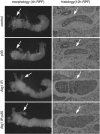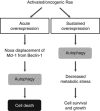Cell death by autophagy: facts and apparent artefacts
- PMID: 22052193
- PMCID: PMC3252836
- DOI: 10.1038/cdd.2011.146
Cell death by autophagy: facts and apparent artefacts
Abstract
Autophagy (the process of self-digestion by a cell through the action of enzymes originating within the lysosome of the same cell) is a catabolic process that is generally used by the cell as a mechanism for quality control and survival under nutrient stress conditions. As autophagy is often induced under conditions of stress that could also lead to cell death, there has been a propagation of the idea that autophagy can act as a cell death mechanism. Although there is growing evidence of cell death by autophagy, this type of cell death, often called autophagic cell death, remains poorly defined and somewhat controversial. Merely the presence of autophagic markers in a cell undergoing death does not necessarily equate to autophagic cell death. Nevertheless, studies involving genetic manipulation of autophagy in physiological settings provide evidence for a direct role of autophagy in specific scenarios. This article endeavours to summarise these physiological studies where autophagy has a clear role in mediating the death process and discusses the potential significance of cell death by autophagy.
Figures




Similar articles
-
Apoptosis and autophagy function cooperatively for the efficacious execution of programmed nurse cell death during Drosophila virilis oogenesis.Autophagy. 2007 Mar-Apr;3(2):130-2. doi: 10.4161/auto.3582. Epub 2007 Apr 7. Autophagy. 2007. PMID: 17183224
-
Drosophila Atg7: required for stress resistance, longevity and neuronal homeostasis, but not for metamorphosis.Autophagy. 2008 Apr;4(3):357-8. doi: 10.4161/auto.5572. Epub 2008 Jan 15. Autophagy. 2008. PMID: 18216496
-
Autophagy, not apoptosis, is essential for midgut cell death in Drosophila.Curr Biol. 2009 Nov 3;19(20):1741-6. doi: 10.1016/j.cub.2009.08.042. Epub 2009 Oct 8. Curr Biol. 2009. PMID: 19818615 Free PMC article.
-
Autophagy as a pro-death pathway.Immunol Cell Biol. 2015 Jan;93(1):35-42. doi: 10.1038/icb.2014.85. Epub 2014 Oct 21. Immunol Cell Biol. 2015. PMID: 25331550 Review.
-
Autophagy-dependent cell death.Cell Death Differ. 2019 Mar;26(4):605-616. doi: 10.1038/s41418-018-0252-y. Epub 2018 Dec 19. Cell Death Differ. 2019. PMID: 30568239 Free PMC article. Review.
Cited by
-
Cell death in genome evolution.Semin Cell Dev Biol. 2015 Mar;39:3-11. doi: 10.1016/j.semcdb.2015.02.014. Epub 2015 Feb 25. Semin Cell Dev Biol. 2015. PMID: 25725369 Free PMC article. Review.
-
Phosphatidic acid mediates the targeting of tBid to induce lysosomal membrane permeabilization and apoptosis.J Lipid Res. 2012 Oct;53(10):2102-2114. doi: 10.1194/jlr.M027557. Epub 2012 Jul 3. J Lipid Res. 2012. PMID: 22761256 Free PMC article.
-
The Roles of Mitochondrial Damage-Associated Molecular Patterns in Diseases.Antioxid Redox Signal. 2015 Dec 10;23(17):1329-50. doi: 10.1089/ars.2015.6407. Epub 2015 Aug 17. Antioxid Redox Signal. 2015. PMID: 26067258 Free PMC article.
-
Mechanisms of radiation toxicity in transformed and non-transformed cells.Int J Mol Sci. 2013 Jul 31;14(8):15931-58. doi: 10.3390/ijms140815931. Int J Mol Sci. 2013. PMID: 23912235 Free PMC article. Review.
-
Precise Expression of Afmed15 Is Crucial for Asexual Development, Virulence, and Survival of Aspergillus fumigatus.mSphere. 2020 Oct 7;5(5):e00771-20. doi: 10.1128/mSphere.00771-20. mSphere. 2020. PMID: 33028685 Free PMC article.
References
-
- Galluzzi L, Vitale I, Abrams JM, Alnemri ES, Baehrecke EH, Blagosklonny MV, et al. Molecular definitions of cell death subroutines: recommendations of the Nomenclature Committee on Cell Death 2012 Cell Death Differ 2011. e-pub ahead of print 15 July 2011; doi:10.1038/cdd.2011.96 - DOI - PMC - PubMed
-
- Kumar S. Caspase function in programmed cell death. Cell Death Differ. 2007;14:32–43. - PubMed
Publication types
MeSH terms
Substances
LinkOut - more resources
Full Text Sources
Molecular Biology Databases
Research Materials

